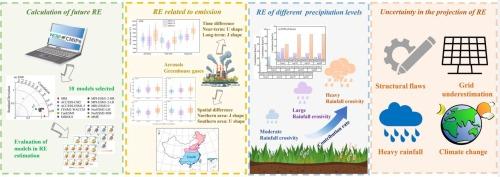基于CMIP6模式的中国东部季风区降雨侵蚀力预测
IF 5.7
1区 农林科学
Q1 GEOSCIENCES, MULTIDISCIPLINARY
引用次数: 0
摘要
利用CMIP6的10个全球气候模式(GCMs)在3种排放情景(低:SSP1-2.6,中:SSP3-7.0,高:SSP5-8.5)下的降尺度和偏差校正,对2030 - 2100年中国东部季风区(EMR)的降雨侵蚀力(RE)进行了预测。结果表明:(1)多模式集合(MME)对总RE的贡献率优于单个模式,华北地区高估,东北和华东地区低估;(2)预计未来年RE将增加。近期(2030-2064),在SSP1-2.6、SSP3-7.0、SSP5-8.5情景下分别增长34.75%、25.09%和34.62%。在相同情景下,长期(2066-2100)可再生能源将分别增长41.24%、43.51%和55.43%。预计排放的持续增加将在短期内最初降低可再生能源,随后增加,但在长期内持续提高可再生能源。(3)区域间可再生能源和排放情景关系存在差异。在华南、华东和华南地区(东、南),年RE随排放量的增加先减小后增大。相反,在北方地区,东北和华北(NEC和NC),更高的排放始终导致更高的侵蚀。这归因于气溶胶和温室气体对降水的不同影响。(4)重RE在整个EMR中占主导地位,其对总RE的贡献将随着极端降水的增加而增加。(5)近地表温度(tas)是影响可再生能源的最主要因子,尤其是对大、重可再生能源,二者正相关关系随着排放的增加而增强。该研究为预测未来的侵蚀风险和指导气候变暖下的土壤和环境政策提供了见解。本文章由计算机程序翻译,如有差异,请以英文原文为准。

Prediction of rainfall erosivity in Eastern Monsoon Region in China based on CMIP6 models
This study forecasts the rainfall erosivity (RE) in the Eastern Monsoon Region (EMR) of China from 2030 to 2100, utilizing downscaling and bias correction of 10 Global Climate Models (GCMs) from CMIP6 under three emission scenarios (low: SSP1-2.6, medium: SSP3-7.0, high: SSP5-8.5). It also investigates the contribution rate of RE produced by different precipitation levels to the overall RE. Findings include: (1) The multi-model ensemble (MME) performs better than individual models, with overestimations in North China and underestimations in Northeast China and East China. (2) Future annual RE is projected to increase. In the near term (2030–2064), it will rise by 34.75%, 25.09% and 34.62% under SSP1-2.6, SSP3-7.0, SSP5-8.5 scenarios respectively. In the long term (2066–2100) the RE will increase by 41.24%, 43.51%, and 55.43% under the same scenarios. A continuous increase in emissions is projected to initially decrease RE in the near-term, followed by an increase, but consistently raise RE in the long-term. (3) RE and emission scenario relationships vary regionally. In the southern regions, East China and South China (EC and SC), annual RE decreases and then increases as emissions rise. Conversely, in the northern regions, Northeast China and North China (NEC and NC), higher emissions consistently lead to higher erosion. This is attributed to differing aerosol and greenhouse gas impacts on precipitation. (4) Heavy RE dominates in the entire EMR and its contribution to total RE is expected to rise due to increasing extreme precipitation. (5) Near-surface temperature (tas) is the most influential factor for RE, especially for large and heavy RE, with positive correlations that intensify under higher emissions. This study offers insights for anticipating future erosion risks and guiding soil and environmental policy in a warming climate.
求助全文
通过发布文献求助,成功后即可免费获取论文全文。
去求助
来源期刊

Catena
环境科学-地球科学综合
CiteScore
10.50
自引率
9.70%
发文量
816
审稿时长
54 days
期刊介绍:
Catena publishes papers describing original field and laboratory investigations and reviews on geoecology and landscape evolution with emphasis on interdisciplinary aspects of soil science, hydrology and geomorphology. It aims to disseminate new knowledge and foster better understanding of the physical environment, of evolutionary sequences that have resulted in past and current landscapes, and of the natural processes that are likely to determine the fate of our terrestrial environment.
Papers within any one of the above topics are welcome provided they are of sufficiently wide interest and relevance.
 求助内容:
求助内容: 应助结果提醒方式:
应助结果提醒方式:


